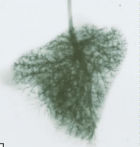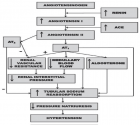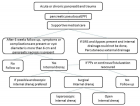Abstract
Case Report
Idiopathic ascites following caesarean section: A case report
Jessica Tate*, Niamh McGrath and Savita Lalchandani
Published: 01 November, 2022 | Volume 5 - Issue 4 | Pages: 093-095
Ms X is a 40-year-old gravida 12, para 2+9 woman, who was admitted for an elective caesarean section at 38 weeks gestation following the previous two caesarean sections. Ms X had abdominal distension and generalised abdominal tenderness in the postoperative period. On investigation, she was found to have an elevated white cell count (WCC), C - Reactive Protein (CRP) and creatinine with free fluid in the abdomen on imaging but there was no evidence of perforation of any visceral organ. Ms X was treated conservatively for sepsis, an Acute Kidney Injury (AKI) and post-operative ileus and her symptoms gradually resolved. This is a case of idiopathic ascites post caesarean delivery with no clear cause.
Read Full Article HTML DOI: 10.29328/journal.cjog.1001114 Cite this Article Read Full Article PDF
Keywords:
Ascites; Idiopathic; Post-caesarean
References
- Sandhu N, Singh S. An unusual case of postoperative ascites after cesarean section. International Journal of Reproduction, Contraception, Obstetrics and Gynecology. 2020 Jun 1;9(6):2635-8.
- Roberts CL, Nippita TA. International caesarean section rates: the rising tide. Lancet Glob Health. 2015 May;3(5):e241-2. doi: 10.1016/S2214-109X(15)70111-7. Epub 2015 Apr 9. PMID: 25866356..
- Dempsey A, Diamond KA, Bonney EA, Myers JE. Caesarean section: techniques and complications. Obstetrics, Gynaecology & Reproductive Medicine. 2017; 1:27(2);37-43.
- Alabrah PW, Agbo J, Agoro ES. Preeclampsia complicated by antenatal & postnatal ascites. European Journal of Medicine & Health Sciences. 2019;1:5.
- Caesarean Section. Consent Advice No. 7, Royal College of Obstetricians & Gynaecologists. Greentop Guidelines. 2009.
- Ko PC, Lo TS, Ashok K. Urinary ascites with elevated blood creatinine following cesarean section indicating bladder injury. Taiwan J Obstet Gynecol. 2011 Dec;50(4):537-9. doi: 10.1016/j.tjog.2011.10.027. PMID: 22212334.
- Al-Busafi SA, Ghali P, Deschênes M, Wong P. Chylous Ascites: Evaluation and Management. ISRN Hepatol. 2014 Feb 3;2014:240473. doi: 10.1155/2014/240473. PMID: 27335837; PMCID: PMC4890871.
- Thompson KA, Al Khabbaz A. Incidental Chylous Ascites at the Time of Cesarean Section. Case Rep Obstet Gynecol. 2015;2015:530210. doi: 10.1155/2015/530210. Epub 2015 Jun 15. PMID: 26171264; PMCID: PMC4485536.
- Betran AP, Ye J, Moller AB, Souza JP, Zhang J. Trends and projections of caesarean section rates: global and regional estimates. BMJ Glob Health. 2021 Jun;6(6):e005671. doi: 10.1136/bmjgh-2021-005671. PMID: 34130991; PMCID: PMC8208001.
- Aponte EM, Katta S, O'Rourke MC. Paracentesis. In: StatPearls. Treasure Island (FL). 2022. https://www.ncbi.nlm.nih.gov/books/NBK435998/
- Epstein NE. Multidisciplinary in-hospital teams improve patient outcomes: A review. Surg Neurol Int. 2014 Aug 28;5(Suppl 7):S295-303. doi: 10.4103/2152-7806.139612. PMID: 25289149; PMCID: PMC4173201.
Figures:
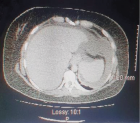
Figure 1
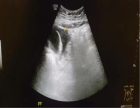
Figure 2
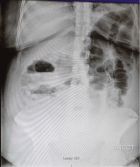
Figure 3
Similar Articles
-
Unilateral pleural effusion as the sole presentation of ovarian hyperstimulation syndrome (OHSS)Tarique Salman*,Suruchi Mohan,Yasmin Sana. Unilateral pleural effusion as the sole presentation of ovarian hyperstimulation syndrome (OHSS). . 2020 doi: 10.29328/journal.cjog.1001074; 3: 182-184
-
A rare case of giant ovarian serous cystadenoma presenting as psuedo-meigs syndromeRichmond Ronald Gomes*,Sayeda Noureen,Habiba Akhter. A rare case of giant ovarian serous cystadenoma presenting as psuedo-meigs syndrome. . 2021 doi: 10.29328/journal.cjog.1001078; 4: 010-014
-
Immunohistochemical expression of p53 and Fox A1 in epithelial ovarian cancerAfaf T Elnashar*,Esraa M Youssef. Immunohistochemical expression of p53 and Fox A1 in epithelial ovarian cancer. . 2022 doi: 10.29328/journal.cjog.1001109; 5: 061-066
-
Idiopathic ascites following caesarean section: A case reportJessica Tate*,Niamh McGrath,Savita Lalchandani. Idiopathic ascites following caesarean section: A case report. . 2022 doi: 10.29328/journal.cjog.1001114; 5: 093-095
-
Meigs syndrome: About an uncommon case reportAziz Slaoui*,Hanaa Lazhar,Noha Amail,Najia Zeraidi,Amina Lakhdar,Aicha Kharbach,Aziz Baydada. Meigs syndrome: About an uncommon case report. . 2023 doi: 10.29328/journal.cjog.1001120; 6: 010-013
Recently Viewed
-
Cystoid Macular Oedema Secondary to Bimatoprost in a Patient with Primary Open Angle GlaucomaKonstantinos Kyratzoglou*,Katie Morton. Cystoid Macular Oedema Secondary to Bimatoprost in a Patient with Primary Open Angle Glaucoma. Int J Clin Exp Ophthalmol. 2025: doi: 10.29328/journal.ijceo.1001059; 9: 001-003
-
Metastatic Brain Melanoma: A Rare Case with Review of LiteratureNeha Singh,Gaurav Raj,Akshay Kumar,Deepak Kumar Singh,Shivansh Dixit,Kaustubh Gupta*. Metastatic Brain Melanoma: A Rare Case with Review of Literature. J Radiol Oncol. 2025: doi: ; 9: 050-053
-
Depression as a civilization-deformed adaptation and defence mechanismBohdan Wasilewski*,Olha Yourtsenyuk,Eugene Egan. Depression as a civilization-deformed adaptation and defence mechanism. Insights Depress Anxiety. 2020: doi: 10.29328/journal.ida.1001013; 4: 008-011
-
Drinking-water Quality Assessment in Selective Schools from the Mount LebanonWalaa Diab, Mona Farhat, Marwa Rammal, Chaden Moussa Haidar*, Ali Yaacoub, Alaa Hamzeh. Drinking-water Quality Assessment in Selective Schools from the Mount Lebanon. Ann Civil Environ Eng. 2024: doi: 10.29328/journal.acee.1001061; 8: 018-024
-
Rapid Microbial Growth in Reusable Drinking Water BottlesQishan Liu*,Hongjun Liu. Rapid Microbial Growth in Reusable Drinking Water Bottles. Ann Civil Environ Eng. 2017: doi: 10.29328/journal.acee.1001007; 1: 055-062
Most Viewed
-
Evaluation of Biostimulants Based on Recovered Protein Hydrolysates from Animal By-products as Plant Growth EnhancersH Pérez-Aguilar*, M Lacruz-Asaro, F Arán-Ais. Evaluation of Biostimulants Based on Recovered Protein Hydrolysates from Animal By-products as Plant Growth Enhancers. J Plant Sci Phytopathol. 2023 doi: 10.29328/journal.jpsp.1001104; 7: 042-047
-
Sinonasal Myxoma Extending into the Orbit in a 4-Year Old: A Case PresentationJulian A Purrinos*, Ramzi Younis. Sinonasal Myxoma Extending into the Orbit in a 4-Year Old: A Case Presentation. Arch Case Rep. 2024 doi: 10.29328/journal.acr.1001099; 8: 075-077
-
Feasibility study of magnetic sensing for detecting single-neuron action potentialsDenis Tonini,Kai Wu,Renata Saha,Jian-Ping Wang*. Feasibility study of magnetic sensing for detecting single-neuron action potentials. Ann Biomed Sci Eng. 2022 doi: 10.29328/journal.abse.1001018; 6: 019-029
-
Pediatric Dysgerminoma: Unveiling a Rare Ovarian TumorFaten Limaiem*, Khalil Saffar, Ahmed Halouani. Pediatric Dysgerminoma: Unveiling a Rare Ovarian Tumor. Arch Case Rep. 2024 doi: 10.29328/journal.acr.1001087; 8: 010-013
-
Physical activity can change the physiological and psychological circumstances during COVID-19 pandemic: A narrative reviewKhashayar Maroufi*. Physical activity can change the physiological and psychological circumstances during COVID-19 pandemic: A narrative review. J Sports Med Ther. 2021 doi: 10.29328/journal.jsmt.1001051; 6: 001-007

HSPI: We're glad you're here. Please click "create a new Query" if you are a new visitor to our website and need further information from us.
If you are already a member of our network and need to keep track of any developments regarding a question you have already submitted, click "take me to my Query."






